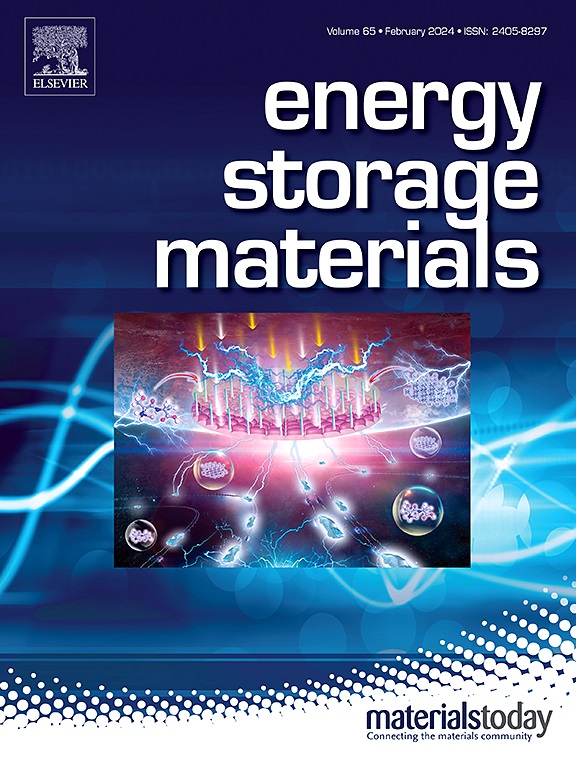Zwitterionic Poly(ionic liquid) Hydrogel Electrolytes with High-Speed Ion Conduction Channels for Dendrite-Free, Long-Enduring Zinc-Ion Batteries and Flexible Electronics
IF 18.9
1区 材料科学
Q1 CHEMISTRY, PHYSICAL
引用次数: 0
Abstract
Flexible zinc-ion batteries (ZIBs) based on hydrogel electrolytes are an important power source for the next generation of soft electronics. However, dendrite growth, intense parasitic reactions and sluggish zinc-ion conduction pose challenges to their practical application. Herein, a zwitterionic poly(ionic liquid) hydrogel electrolyte (PICZ) is proposed to fabricate high-performance and stable ZIBs. The interaction between zwitterionic liquid (CAVIm) and chitosan builds a unique ion migration channel to facilitate the high-speed Zn2+ transport kinetics. The hydrogel electrolyte with abundant hydrophilic groups immobilizes water molecules to reduce side reactions and corrosion. The carboxyl groups of CAVIm are inserted into the primary solvation sheath of Zn2+ to reduce the desolvation energy barrier and enhance ion transport kinetics. Zn2+ is uniformly deposited onto the (002) crystal plane to inhibit dendrite growth. The symmetric cells assembled with PICZ exhibit an ultra-long cycling life exceeding 7000 h, and excellent cycling stability in both AC supercapacitors and NVO full cells. Furthermore, the hydrogel electrolyte is applied as flexible electronics that are integrated with the assembled ZIBs to realize self-powered sensing. This study will offer an efficient strategy for developing ZIBs with high flexibility and stability.

具有高速离子传导通道的两性离子聚(离子液体)水凝胶电解质,用于无枝晶、长效锌离子电池和柔性电子产品
基于水凝胶电解质的柔性锌离子电池(ZIBs)是下一代软电子产品的重要电源。然而,枝晶生长、强烈的寄生反应和缓慢的锌离子传导给它们的实际应用带来了挑战。本文提出了一种两性离子聚(离子液体)水凝胶电解质(PICZ)来制备高性能和稳定的ZIBs。两性离子液体(CAVIm)与壳聚糖的相互作用建立了独特的离子迁移通道,促进了Zn2+的高速迁移动力学。水凝胶电解质具有丰富的亲水性基团,可以固定水分子,减少副反应和腐蚀。CAVIm的羧基插入到Zn2+的初级溶剂化鞘层中,降低了脱溶能垒,提高了离子传输动力学。Zn2+均匀沉积在(002)晶面上,抑制枝晶生长。用PICZ组装的对称电池具有超过7000 h的超长循环寿命,并且在交流超级电容器和NVO全电池中都具有出色的循环稳定性。此外,将水凝胶电解质作为柔性电子元件与组装的zib集成,实现自供电传感。该研究将为开发具有高灵活性和稳定性的ZIBs提供有效的策略。
本文章由计算机程序翻译,如有差异,请以英文原文为准。
求助全文
约1分钟内获得全文
求助全文
来源期刊

Energy Storage Materials
Materials Science-General Materials Science
CiteScore
33.00
自引率
5.90%
发文量
652
审稿时长
27 days
期刊介绍:
Energy Storage Materials is a global interdisciplinary journal dedicated to sharing scientific and technological advancements in materials and devices for advanced energy storage and related energy conversion, such as in metal-O2 batteries. The journal features comprehensive research articles, including full papers and short communications, as well as authoritative feature articles and reviews by leading experts in the field.
Energy Storage Materials covers a wide range of topics, including the synthesis, fabrication, structure, properties, performance, and technological applications of energy storage materials. Additionally, the journal explores strategies, policies, and developments in the field of energy storage materials and devices for sustainable energy.
Published papers are selected based on their scientific and technological significance, their ability to provide valuable new knowledge, and their relevance to the international research community.
 求助内容:
求助内容: 应助结果提醒方式:
应助结果提醒方式:


